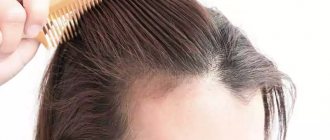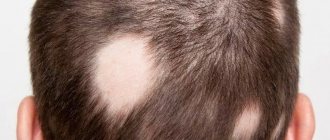Dermatologist (trichologist)
Saperova
Olga Ivanovna
Doctor
Make an appointment
The term “diffuse alopecia” refers to the loss of hair over the entire surface of the head, less often throughout the body. The main symptom is the loss of a significant amount of hair every day, which leads to the appearance of noticeable bald patches. The disease occurs with equal frequency in children and adults, and the intensity of its symptoms does not depend on age. More often, the pathology is diagnosed in women, which may be due to increased attention to one’s own appearance and an immediate reaction to noticed changes.
Features of the problem
For a girl, curls are an indicator of her self-care. Scientists have proven that dull and sparse strands indicate vitamin deficiency or complete exhaustion. While thick and shiny curls indicate the harmony of all processes occurring in the body.
Even during the times of Kievan Rus, a long braid was the pride of any female representative. For men, luxuriant hair is not such a significant indicator of beauty, however, thinning of the scalp also serves as evidence of a disorder in the functioning of the body.
Wanting to understand what diffuse alopecia is and how to treat it, you need to turn to the medical classification of diseases. The definition of this phrase is hair loss over the entire surface of the scalp, which is consistent and symmetrical. If a healthy person experiences a loss of 25 to 125 units per day, which is considered normal, then the disease is accompanied by a loss of 150 to 1000 or more per day.
It is necessary to turn to human anatomy to understand the mechanism of baldness. Before appearing on the surface, the hair goes through several stages of formation: ● Anagen phase. The first stage, during this process, active division of cells responsible for growth is observed, pigment (melanin) is produced, which ensures the presence of a certain shade of the strands and the shaft appears. The duration of such manifestations ranges from two to seven years. ● Catagen phase. The activity of this stage is manifested by abundant growth, the duration is fourteen days. The follicle shrinks, melanin production stops, and the rod departs and moves to the epidermis (skin). ● Telogen phase. The final process of the cycle, which consists of the bulb entering a state of rest, individual curls falling out and being easily removed during combing procedures. The stage lasts about ninety days and precedes the birth of a new hair.
Causes include a wide range of physical or emotional stress, nutritional deficiencies, and endocrine disorders. Determining the cause ensures appropriate treatment.
Summary
Diffuse hair loss can occur in both sexes and at any age. Anything that interrupts the normal hair growth cycle can also cause diffuse hair loss. Causes include a wide range of physical or emotional stress, nutritional deficiencies, and endocrine disorders. Determining the cause ensures appropriate treatment. Telogen hair loss is the most common. Hair loss during the anagen phase is usually caused by chemotherapy or radiation therapy. Determining the cause, or trigger, of hair loss requires a thorough history and examination of the patient, and allows appropriate treatment to be prescribed. Patient education is key in treating diffuse hair loss.
Key points
- Early androgenetic alopecia may look like episodic telogen effluvium until female pattern hair loss becomes noticeable.
— Diffuse telogen effluvium is a symptom of an underlying condition and thus is not a complete diagnosis in itself.
— Androgenetic alopecia, which is an important cause of diffuse telogen effluvium, should not be overlooked.
Diffuse hair loss is distressing. In many cases, the patient notices an increase in hair loss on the pillow, while combing their hair, or in the shower (1). Women tend to recognize problems more easily than men (1,2). However, diffuse hair loss can occur in both sexes and at any age.
In this article we will look at the causes of diffuse hair loss and determine the approach to diagnosis and treatment.
Normal hair growth and life cycle
Hair on the scalp grows in cycles, and each hair follicle can enter a new cycle 10-30 times throughout its life (3). Diffuse hair loss is the result of the cessation of one of the phases of the hair growth cycle (2.4), i.e. anagen (active hair growth), catagen (involution), or telogen (rest) (Figure 1). The anagen phase lasts from 2 to 8 years (5), the catagen phase lasts from 4 to 6 weeks, and the telogen phase lasts from 2 to 3 months (5). The exogen phase (removal of “dead” hair) coincides with the end of the telogen phase (6).
Typically, the cycle of each hair follicle is independent of each other, so while some hair grows, others rest and still others fall out. Thus, the density of hair on the head and its total number remain constant. Most people have about 100,000 hairs on their scalp, and typically 10% to 15% of them are in telogen (6). Therefore, losing 100 to 150 telogen hairs per day is normal (5). Anegen alopecia can never be a normal process.
The most common type of diffuse hair loss is diffuse telogen effluvium, in which hair follicles in the anagen phase prematurely enter the telogen phase, resulting in a noticeable increase in hair loss at the end of the telogen phase after 2-3 months (2,4). Diffuse telogen effluvium is a symptom of an underlying condition and thus is not a complete diagnosis in itself.
Differential diagnosis of diffuse alopecia
Diffuse telogen effluvium has many triggers and these determine the characteristics of telogen effluvium hair loss.
Diffuse telogen effluvium can be acute (lasting less than 6 months), chronic (6 months or more), or chronically recurrent (1,7). If the trigger is acute and short-acting, diffuse telogen effluvium is likely to be acute and self-limiting. If the trigger is constant and/or repetitive, or there are multiple triggers in succession, or the trigger does not stop, then telogen effluvium hair loss may be continuous (7).
Rule out androgenetic alopecia. It is important to distinguish telogen effluvium from early androgenetic alopecia (female pattern hair loss). Early androgenetic alopecia may appear as episodic telogen effluvium until female pattern hair loss becomes noticeable (8). Androgenetic alopecia is a specific condition, but signs of telogen effluvium may also be noted.
Anagen effluvium
Anagen hair loss occurs due to premature cessation of anagen hair growth, or anagen retention, following acute, severe metabolic stress (9). The most common iatrogenic alopecia is caused by the use of cytotoxic drugs (9,10) or radiation (9).
Rule out alopecia areata. It is important to distinguish anagen hair loss from alopecia areata. A detailed history and examination of the patient to determine the temporal relationship of possible triggers and any underlying systemic disease should be done for patients with hair loss. In some cases, additional examination is required.
Causes of diffuse telogen effluvium hair loss
The causes of diffuse telogen effluvium hair loss are numerous (2,4,11–13).
Physiological stress
Physiological stress, such as surgical trauma (4), high fever (4), chronic systemic disease (4) and blood loss (11), is a well-known cause of telogen effluvium hair loss, beginning 2-3 months after exposure. Telogen effluvium hair loss can begin 2-4 months after the baby is born (reactive postpartum alopecia) (4).
Emotional stress
The relationship between emotional stress and hair loss is very difficult to establish, and hair loss itself is very stressful for the patient (14). Acute, reversible hair loss can usually be detected, occurring after severe stress (11). In contrast, the relationship between chronic diffuse hair loss and psychological stress is controversial (11,14). The evidence for this association appears to be weak, and it is believed that everyday stress is probably not enough to cause hair loss (3,14).
Diseases of internal organs and systems
Both hypothyroidism and hyperthyroidism can lead to diffuse telogen effluvium hair loss, which is usually reversible once a euthyroid state is restored (9,11). Chronic systemic diseases such as systemic amyloidosis (14), liver failure (4), chronic renal failure (4), inflammatory bowel disease (4,14) and lymphoproliferative diseases (2) can cause telogen effluvium hair loss. Telogen effluvium may also occur with autoimmune diseases such as systemic lupus erythematosus and dermatomyositis (14), as well as with chronic infections such as human immunodeficiency virus type 19 and secondary syphilis (11). Inflammatory diseases such as psoriasis, seborrheic dermatitis, and allergic contact dermatitis can all cause diffuse telogen effluvium (7,15).
Diet triggers
Nutritional causes of diffuse telogen effluvium are zinc and iron deficiency (11,14). Heavy protein intake, decreased fatty acid intake, and caloric restriction with chronic fasting (2,11,14) and abrupt dieting (12) can also cause diffuse telogen effluvium hair loss. Malabsorption syndrome and pancreatic disease may exacerbate telogen effluvium (11). Deficiency of essential fatty acids may also be associated with diffuse telogen effluvium hair loss, which occurs 2-4 months after insufficient fatty acid intake(11). Vitamin D is an essential vitamin in cell growth, and vitamin D deficiency may be associated with diffuse hair loss (1,7). Biotin deficiency can also lead to alopecia, but this is a very rare cause of hair loss (14).
Medicines that cause hair loss
Drugs can cause telogen effluvium hair loss, which begins approximately 12 weeks after starting the drug and continues as long as the patient takes the medication (10). Changes in your medication dose may also increase hair loss (7). Any medications or dietary supplements may be suspected as causing hair loss.
Known medications that can cause diffuse telogen effluvium include oral contraceptives, androgens, systemic retinoids, beta blockers, ACE inhibitors, anticonvulsants, antidepressants, and the anticoagulants heparin and warfarin (Coumadin) (10,14). Changing or discontinuing any oral contraceptive may worsen telogen effluvium (10,14). Oral contraceptives containing androgen progestin and hormone replacement therapy with high dose progesterone can lead to telogen effluvium without any distinguishing signs (7,11,14).
Identifying causes
Normal prolapse usually goes unnoticed by the patient. Conversely, at the onset of telogen effluvium, hair loss is felt to increase by 25% (7).
In order to determine the true cause of telogen effluvium, the relationship between the trigger and hair loss must be reproducible, with a decrease in hair loss following correction or elimination of the trigger, and worsening when the trigger is reintroduced (3).
In acute diffuse telogen effluvium, that is, with the acute onset of telogen effluvium hair loss 2-3 months after the action of an acute, short-term factor (4), a detailed history is important to determine the exact time relationship. In some cases, no trigger(2) can be set. Hair regrowth is not visible to the eye for 4-6 months (7). If the trigger is identified and eliminated, complete restoration of hair growth can be expected (4,7).
In chronic diffuse telogen effluvium hair loss, that is, when telogen effluvium continues for more than 6 months (3,14), a number of triggers can increase hair loss. Also, telogen effluvium hair loss lasting more than 6 months can occur due to chronic idiopathic telogen effluvium hair loss. It may also be secondary to long-term, sequential, or recurring triggers such as nutritional deficiencies or an underlying systemic disease, and hair loss may be less severe than with acute telogen effluvium (7).
Chronic telogen effluvium is an idiopathic condition with telogen hair loss lasting more than 6 months, and with an intermittent chronicity over many years without an identifiable trigger (16,17). These patients may have a mop of hair or bitemporal recession without widening of the midsection (16,17). Histological examination shows no miniaturization of hair follicles (17). The diagnosis of chronic diffuse telogen effluvium is made by excluding causes of diffuse telogen effluvium hair loss, including androgenetic alopecia.
Androgenetic alopecia usually appears as a well-defined pattern of hair loss on the scalp in patients with a family history of the condition. Characteristic is (14,18) diffuse hair loss with accentuation on the crown of the head and widening of the central parting in women, with or without frontal accentuation (in the form of a “Christmas tree”).
The mechanism of development of female pattern hair loss is associated with a shortening of the anagen phase and progressive miniaturization of hair follicles (18). In some cases, androgenetic alopecia may manifest as diffuse scalp hair loss with occasional increases in telogen effluvium (8,14). This manifestation may be mistaken for other causes of diffuse telogen effluvium hair loss.
Although most women with female pattern hair loss have normal androgen levels (14), diseases associated with excess androgens, such as polycystic ovary syndrome, can lead to diffuse hair loss on the scalp or female pattern hair loss ( 7.18). Laboratory studies can rule out other causes of telogen effluvium, and androgen screening should be performed in women who have signs of androgen excess, such as irregular menstrual cycles, hirsutism, or acne (18). A scalp biopsy can confirm the diagnosis of androgenetic alopecia (14).
Anagen effluvium: main characteristics
Anagen hair loss, a result of anagen interruption in the hair growth cycle, is sudden anagen hair loss with severe diffuse alopecia on the scalp(9). Severe toxicity to hair follicles can lead to loss of up to 80% of scalp hair (7). The time period from the trigger for hair loss in anagen effluvium is shorter than in telogen effluvium, with hair loss occurring after a few days or weeks (9). The hair pulling test (see below) is positive with dystrophic anagen hairs with tapered ends (9). After the negative factor ceases, hair growth resumes within a few weeks.
Causes of anagen hair loss include cancer therapy and alopecia areata.
Antimitotic chemotherapy drugs cause a delay in the anagen phase and cause toxic effects on the cells of the rapidly dividing hair follicle matrix (9). Hair loss usually begins 1 to 2 weeks after chemotherapy and becomes most noticeable after 1 to 2 months (19). Hair on the scalp is most affected, but all hair on the body, including eyelashes and eyebrows, can also be affected (10).
Other triggers for anagen hair loss include radiation (9), heavy metal and boric acid poisoning (19). It is also known that radiation can cause telogen effluvium and scarring alopecia (9,10.
Alopecia areata is another cause of hair loss during the anagen phase (9). This autoimmune scalp disease (20) can cause patchy hair loss on the scalp, complete loss of scalp hair (alopecia totalis), or complete loss of scalp and body hair (alopecia universalis).
Importance of history taking in determining causes
A carefully collected history is the key to understanding the reasons that caused diffuse prolapse in each specific case (Table 1). The duration of hair loss and whether the loss is permanent or episodic should be noted. The patient can also estimate the percentage of hair lost.
In the case of telogen effluvium, the history should primarily cover events during the 3 months before the onset of hair loss. Recent illness or surgery should be recorded. A dietary history may also be helpful (21). A detailed list of medications taken, including new medications or dietary supplements, should be recorded, as well as any changes in dosage.
As mentioned above, other factors that are important to find out include: recent chemotherapy or radiation therapy, family history of hair loss such as androgenetic alopecia, use of oral contraceptives and hormone replacement therapy.
Clinical examination of the patient
Given the difficulty of diagnosing diffuse hair loss, clinical examination is of great importance. It is necessary to determine the condition of the scalp, the degree of hair loss and the presence of female pattern hair loss. Hair shafts should be assessed for length, diameter, and degree of fragility (21). On the scalp, you need to pay attention to the presence of inflammation, redness and flaking (21).
The hair pulling test should be performed on all patients with hair loss (22). To do this, you need to gently pull a strand of hair from 25 to 50 pieces. from roots to ends. Typically, only 1 or 2 hairs are removed (1). If hair loss is present, 10 to 15 hairs may be removed during the test (1). Light microscopy helps differentiate whether the hair types removed are telogen hair or dystrophic anagen hair (1). Hair shaft microscopy may also indicate the presence of nutritional deficiencies (11).
A daily count of hair loss can be helpful (22). Hair is collected (7) by the patient at home for 2 weeks (7). Lost hair is collected daily at a specific time, usually in the morning, and placed in dated envelopes. It is important to note the dates of hair washing (7). Losing more than 100 hairs per day means you have hair loss (7). The hair can then be examined and classified as either telogen or anagen.
Laboratory tests and scalp biopsy
Laboratory tests can determine the triggers or causes of diffuse telogen effluvium hair loss. The examination should include the following:
Complete blood count and serum ferritin level to diagnose anemia and iron deficiency.
Free TSH and T4 to detect thyroid diseases.
Serum zinc level – to determine zinc deficiency.
Extensive biochemical analysis to exclude chronic renal pathology or liver diseases.
If the patient's history and clinical examination suggest the presence of systemic lupus erythematosus, appropriate blood tests should be performed. In addition, a blood test for androgen profile should be performed if signs of hyperandrogenism are detected (18) or if hormonal causes are suspected as the cause of telogen effluvium hair loss.
A scalp biopsy can be helpful in most cases of hair loss (21). The absence of identifiable triggers, chronic hair loss, miniaturization of hair shafts, and the inability to rule out alopecia areata are all indications for scalp biopsy (1,2).
It is recommended to take two 4mm biopsies to obtain adequate horizontal and vertical sections (7). As a result, the number of terminal hairs and vellus, the ratio of telogen and anagen hairs are calculated. In acute diffuse telogen effluvium, changes in the normal ratio of anagen and telogen hairs are determined. (23). Miniaturization of hair follicles and a predominance of vellus hair over terminal hair are observed in androgenetic alopecia (23). Characteristic peribulbar lymphocytic inflammation can be seen in alopecia areata (20).
Treatment: The Importance of Patient Education
The most important aspect in treating diffuse telogen effluvium hair loss is to explain to the patient that this hair loss is a natural process. We need to talk about the normal hair growth cycle, as well as the relationship between triggers and timing of hair loss. For example, diffuse telogen effluvium usually begins 2 to 3 months after the trigger, although in rare cases it can begin as early as 2 weeks after the trigger (7).
A health diary or calendar can be helpful to identify triggers. The patient should be taught to record any stress, hospitalization, surgery, new medications, dosage changes, or other potential triggers for hair loss (1,7).
The patient should understand that once the hair loss trigger is eliminated or the underlying condition is treated, hair loss stops, although hair loss may continue for up to 6 months (1). Hair regrowth may be noted 3 to 6 months after the trigger has been removed, but cosmetically acceptable hair regrowth may take 12 to 18 months (1,7).
For acute diffuse telogen effluvium, if the trigger can be identified and eliminated, no further treatment is required (1,4). Patients can be confident that they will not go bald.
Adequate nutrition is very important. If a drug is suspected to be the cause of hair loss, it should be stopped or replaced for at least 3 months to determine whether it is the trigger (3). Any inflammation of the scalp (eg, seborrheic dermatitis or psoriasis) should be treated with antiseborrheic shampoos and topical corticosteroids (1,7).
Chronic diffuse telogen effluvium hair loss is more complex as multiple sequential or repeating triggers may occur (7). Nutritional deficiencies, thyroid diseases, systemic diseases and infections are subject to mandatory treatment.
For acute telogen effluvium hair loss, chronic diffuse telogen effluvium, and chronic recurrent hair loss, administration of biotin and zinc supplements can help restore hair growth (1,7).
Nonspecific treatment is indicated for telogen effluvium, but it has also been noted that topical hair growth stimulant minoxidil (Regaine) 2% and 5% to the scalp once daily may be effective for chronic diffuse telogen effluvium (7) (WF. Bergfeld, personal archive, November 12, 2008).
In men, treatment for androgenetic alopecia includes topical minoxidil 2% or 5% and systemic finasteride (Propecia) (18). Women can also use minoxidil, but only a 2% solution is FDA approved for women with androgenetic alopecia (18). Antiandrogens such as spironolactone (Aldactone) are used for women with off-label androgenetic alopecia. Antiandrogens cause feminization of the male fetus; therefore, all women of childbearing age should use reliable contraception (18). Small studies suggest that spironolactone in combination with oral contraceptives is effective in treating androgenetic alopecia in women (18,24).
Anagen hair loss is usually treated with observation and support, as the cause of the hair loss becomes obvious after talking with the patient. If no iatrogenic causes can be found to trigger anagen hair loss, and then other causes such as alopecia areata and heavy metal poisoning, the underlying disease must be fully studied and treated.
Classification
Depending on the factors of appearance and further symptoms, the disease occurs in two scenarios: 1. Telogen effluvium. Disruption of the developmental cycle can cause hormonal imbalance, in most cases it manifests itself in women within 1–3 months after childbirth. This type of occurrence is characterized by a rapid transition from the first phase to the third. The clinical picture shows that more than 80% of the follicles go into a dormant state, while in a healthy person this indicator is 15%. It is the dysfunction of the internal organs that gives rise to the development of this form of the disease. If they are cured, everything stops. 2. Anagen. The appearance of this type is explained by radiation exposure or an excess of vitamin A in the body, as well as long-term use of medications with an increased concentration of this useful substance. It is characterized by a decrease in the thickness of the rod, which leads to the impossibility of further germination of strands; the curls with follicles at rest are the first to separate. This form of the course is accompanied by complete baldness and occurs in a short time (a period of no more than two weeks) after exposure to the factor.
Causes of the disease
One of the explanations why alopecia occurs more often in women than in the stronger sex is exhaustion of the body. This is the root cause of impaired follicular development. Being under constant nervous tension (stress) or following strict diets affects every organ and the body as a whole.
After doctors conducted a number of surveys and studies, a list of factors accompanying hair loss was compiled: 1. Loads. Stress can be attributed to physical and mental health. Diffuse baldness is equally likely to develop in women - after any type of surgery, prolonged exposure to high temperature, heavy bleeding, or changes in hormonal levels. 2. Chronic diseases and previous infections. We are talking about problems with the gastrointestinal tract, kidneys, the presence of dermatitis, various infections, and allergies. The presence of such a symptom as baldness is observed with HIV and Syphilis. Infections that are also accompanied by hair loss: lupus, tuberculosis, typhoid, influenza strains, malaria. Basically, based on psychosomatic research, any infection can lead to baldness due to the individual's individual reaction. 3. Deficiency of nutrients. With a small amount in the body and an insufficient dose of proteins, minerals and vitamins, the development of similar pathologies of strand growth is observed. In some cases, the cause of diffuse alopecia in women was low selenium levels - improvements were observed after treatment and its harmonization with medication. 4. Taking medications. At every step today we are told about the complications of taking medications, but few people take this problem seriously. There are several groups of drugs that give rise to one form of the disease: cytostatic; to prevent the formation of blood clots; for the treatment of Parkinson's; vitamin A analogues; adrenoreceptor and H2 blockers; means that relieve cramps. 5. Radiation. Due to an accident or deliberate exposure to radiation, uniform loss of hair on the head is observed.
How hair grows and falls out
To better understand the mechanism of such a phenomenon as diffuse alopecia, it is worth learning more about the physiology of hair growth.
The life cycle of any hair consists of three main stages:
- Anagen is active growth that lasts about 2–7 years. The older a person is, the shorter the period when cells actively divide and develop. On average, the phase lasts 4 years. During this time, the hair shaft appears and pigment is formed. Up to 90% of the hair on the body of a healthy person is in this stage.
- Catagen is a period of gradual attenuation of development, deterioration of nutrition, and cessation of growth. The phase lasts approximately 2 weeks. Only 1–2% of the hair is in this stage.
- Telogen is the resting period of the follicles, which lasts approximately 3-4 months. In this phase we have approximately 10–15% hair. All metabolic processes in the follicles stop. The hair falls out, and a new one begins to grow in its place. All phases of the cycle are repeated.
Diffuse alopecia can be in the anagen or telogen stage. In the first case, a person loses new developing hair. This happens when the stress factor is so strong that hair loss occurs almost immediately after its impact (approximately 2 weeks). Entire locks of hair can fall out, and this is a serious concern. But the problem usually goes away on its own if the provoking factor stops acting, so it is necessary to know the causes of diffuse hair alopecia. And in order to accurately establish them, you need to make an appointment with a trichologist.
Telogen effluvium alopecia occurs when at least 20% of the hair on the scalp has entered the telogen stage. This means that something has disrupted the natural development, and the anagen phase has become shorter. The hair began to die faster. In this case, it can be difficult to identify the factor that provoked it, since diffuse loss becomes noticeable approximately 2-4 months after its impact. You have to strain your memory well and remember what you were sick with, what you ate, what events happened, etc.
Diffuse baldness can also be androgenetic, that is, associated with heredity. In men, symptoms may appear at any time after puberty, and in women, symptoms may appear around age 20–30. Acute phases in this case may alternate with periods of remission.
First signs
It is worth noting that this type of pathology is observed in abundance in females, which is explained by the peculiarities of the processes occurring in the human body, depending on gender. The rarest cases of such disorders were found in children and adolescents. The main symptom of diffuse hair loss in women and men is uniform baldness of the entire surface of the head, along with this, doctors note: 1. Widening of the parting. You can observe a sluggish increase in the epidermal line, or a sharp detection of the lumen of the skin of the scalp. 2. Hertog indicators. In this case, the symptoms are described by thinning of the skin and loss of eyebrows or eyelashes. 3. Deterioration of the condition. The strands often begin to break, get tangled, become significantly dull and change their shade, making it possible to easily pull out a hair.
Please note that if you notice several or at least one symptom, sign up for a consultation with a trichologist and undergo an examination in order to prevent a deterioration in your health.
Diagnosis of diffuse alopecia in women
Diffuse alopecia is a disease that is treated by trichologists. After the examination, a woman often needs consultations with an endocrinologist, psychologist, or gastroenterologist. The most common patient of a trichologist is a woman. Because of this, it seems that this disease is not detected as often in men. However, representatives of the stronger sex should also not neglect the symptoms of alopecia and visit a doctor on time.
For quality treatment, it is necessary to find out what is the cause of hair loss. It is necessary to undergo a general examination of the body. It is as follows:
- Blood test: clinical and biochemical. With its help, you can learn about the condition of various organs and systems, detect anemia and problems with the immune system, find out about the presence of inflammation and allergies. Kidney and liver tests are done to check the functioning of the kidneys and liver.
- Checking hormonal status. A woman and a man are tested for the level of sex hormones, adrenal cortex and thyroid hormones.
- Blood test for sugar levels. Hair may begin to fall out in type 1 and type 2 diabetes due to pathological changes in the walls of blood vessels and nerve endings.
- Allergy tests. They are done in order to exclude the presence of atopic dermatitis and other allergic diseases.
- Ultrasound examination of the thyroid gland , abdominal cavity, pelvic organs. These studies are necessary in order to assess the general condition of the body and identify foci of chronic inflammatory processes.
- Tests for helminthiasis. With confirmed helminthic infestation, a disturbance in the condition of the hairline occurs, as metabolism is disrupted and an allergic reaction is detected.
- Immunogram. This study is required if there is a suspicion of immunodeficiency. Without its results, the doctor cannot prescribe immunomodulating or immunostimulating drugs.
- Consultation with a psychologist/psychiatrist. Necessary for identifying and eliminating problems in the psycho-emotional sphere.
The anagen form of the disease is easier to diagnose, since it is easy to trace the connection between the harmful effects of drugs, poisons, radiation and hair loss.
Recommended articles on the topic:
- Hair carving: photos, types, advantages and disadvantages
- Plasma therapy for the scalp
- Useful vitamins for hair: against hair loss and for growth
Diagnostics
When checking for symptoms that contribute to the formation of bald spots, it is necessary to undergo an examination and tests from a number of specialists: trichologist, endocrinologist, dermatologist and gastroenterologist. The presence of central nervous system diseases, endocrine disorders and sexually transmitted infections must be excluded. A visit to specialist doctors will help to display the condition of internal organs and identify the cause of existing indicators of disorder in the functioning of the body. In addition, the patient is required to undergo one of a number of procedures to confirm the conclusion: ● trichoscopy; ● phototrichogram; ● narrowly focused testing for microelements; ● specialized laboratory tests.
There are the following types of elimination of diffuse hair loss and thinning in women: 1. Medicines; 2. Stimulation; 3. Physiotherapy; 4. Folk remedies.
Please note that when trying to cure the appearance of bald spots, traditional recipes can be used only after consultation with a doctor and full confidence that such measures will not harm the patient’s health.
Drug treatment
It consists of taking medications with a focus on restoring hormonal levels or eliminating factors that caused the appearance of pathology. Most often used in combination with stimulation. It is achieved using various external means: specialized shampoos, masks and gels. One of the variations of this group of drugs designed to restore the growth of strands is a product called Selencin. The manufacturer offers the use of cosmetics in the form of shampoo, conditioner, spray and lotion, along with medications. The advantage is an integrated approach to treatment: ● Elimination of causes by taking medications; ● Stimulation of curl germination and strengthening, which is provided by lotions and sprays; ● Restoring thickness through the use of masks.
Specialized studies have shown that with constant use of Selencin products, hair loss stops within two months.
Without fail, the doctor prescribes a course of vitamins of groups A, B, C, PP in tablets along with zinc. Another way to stimulate is to take drugs made from plants. The use of such substances as treatment is not available at all times of the year, and is recommended only after testing and individual consultation.
Treatment of diffuse alopecia in women
To cure diffuse alopecia in women, an integrated approach is required, which includes taking medications, rubbing various medicinal drugs into the scalp, physiotherapy, and nutritional correction.
In any case, the cause of massive hair loss is first determined, then we begin to eliminate it.
It is imperative to undergo a medical examination to rule out:
- Diseases of the liver and thyroid gland.
- Diseases of the adrenal glands and ovaries.
- Problems with the central nervous system.
If diffuse alopecia is detected, the trichologist prescribes phototrichoscopy and tests for the content of trace elements and the level of dihydrotestosterone.
Diffuse alopecia in women can be completely eliminated with timely diagnosis. However, treatment is a long process that requires a lot of effort and patience. To awaken the hair follicles and increase blood flow to them, external agents are used. If it is known for sure that the cause of alopecia is taking certain medications, then have no doubt - after eliminating them, the hair will begin to grow again.
If treatment is started on time, it is possible to stop hair loss within 2–3 months, and restore hair growth within 8–9 months. To prevent a recurrence of the disease, it is better for a woman to forget about hair coloring, perm and blow-drying.
Treatment of alopecia with medications
Excessive hair loss most often becomes the basis of a depressive state in men and women, which in turn further complicates the course of this disease. Therefore, to speed up the treatment of alopecia, it is necessary to “put in order” the emotional background. For severe psychological disorders, medications such as novopassit, tincture of motherwort or valerian will help. In mild cases, tea infused with mint will help. In difficult situations, you need to contact a psychologist or psychiatrist.
To strengthen hair, it is recommended to consume a certain vitamin complex. For baldness, the doctor prescribes oral vitamins A, C, PP and injections of vitamins B1, B6, B12.
To stop excessive hair loss, a specialist may prescribe the following medications:
- minoxidil;
- Cromaclean;
- finasteride.
Minoxidil stimulates the follicles and promotes hair growth. It is used in the treatment of androgenetic alopecia, but it has also shown its effectiveness in diffuse baldness. The medicine is taken every day for a long time. With timely treatment, the effect is visible within 2-3 months, otherwise you will have to treat it for a year.
Cromaclyn also has a similar effect. It is often found in masks, shampoos and balms.
Finasteride is taken only orally and only after a doctor's prescription. This is a male hormonal drug. The effects of finasteride can be felt within 3-6 months after starting to take it.
Hair masks
Hair masks can also have a stimulating effect on the follicles. They are easy to buy at the store or make yourself.
Use the following products to prepare effective masks:
- mustard powder;
- onion;
- garlic;
- red pepper.
To prepare a mask, take one of these components, add vitamins, oils, honey and other beneficial ingredients, mix them and apply to the scalp. Put on a polyethylene cap and wrap a towel around your head.
In addition to masks, you can strengthen your hair and stimulate its growth using balms, gels, lotions with extracts of substances that increase blood flow to the hair follicles.
Drugs intended for the treatment of diffuse alopecia in women will help not only restore hair, but also strengthen it. Nourishing products will make them stronger and healthier.
Read material on the topic: Useful vitamins for hair: against hair loss and for growth
Physiotherapy
Such treatment is reflected in the prescription of a set of procedures that do not harm health. ● Iontophoresis; ● Scalp massage with essential oils; ● Microcurrent therapy; ● Mesotherapy.
Undergoing physical therapy has a number of advantages: ● targeted impact with the likelihood of affecting a certain area of the skin; ● does not cause allergies; ● increasing the duration of remission; ● possibility of use in a complex.
In addition, a specialist may suggest the use of infrared rays, nitrogen, paraffin and acupuncture.
Prevention
Having examined the main causes and methods of treating diffuse hair loss in men and women, we will consider measures to prevent the disease. The development of pathology can be avoided if a number of measures are taken. 1. Watch your diet. 2. Spend proper time on carefully washing your curls and caring for them. 3. Wear hats in summer - to protect from sun rays, and in winter - from temperature changes, and as a result, poor blood circulation to the scalp. 4. Avoid heavy physical activity and stress. 5. Take vitamin complexes in autumn and spring. It is at this time that micronutrient deficiency peaks. 6. Avoid exposure to radioactive radiation. 7. Consult your doctor about the side effects of taking medications. 8. Have a full examination every six months or year. 9. Maintaining the balance of nutrients in the body with proper nutrition. Inclusion in the diet in the required amount of proteins, fats and carbohydrates. All of these methods affect the strengthening of the immune system, which has a positive effect on overall health. This helps to avoid disruption of the normal functioning of the body.
When does diffuse hair loss develop and how long does it last?
Severe hair loss usually develops on average after 3 months from exposure to the causative factor and can last up to 3-4 months, despite concomitant treatment. Proper hair growth begins after eliminating the trigger factor, and volume restoration occurs according to growth standards, which is about 1-1.5 cm per month. Diagnosis of hair loss is relatively complex: it is necessary to collect a detailed history, exclude possible deficient conditions, conduct a phototrichogram, and, based on the totality of the examination results, prescribe effective treatment.
Complications
The worst option is complete loss of hair in the upper area of the skull, and a number of radical measures are used: ● A set of injections; ● Transplantation from other areas of skin with normal vegetation. During injections, the effect occurs on the subcutaneous layer in order to stimulate the follicles for their transition to the growth stage.
Strand transplantation surgery is an effective, but expensive and complex procedure. It usually lasts more than twelve hours. The positive effect can be tracked six months after surgery. A photo of the patient throughout the course of the disease and rehabilitation reflects the effectiveness of treatment procedures to eliminate diffuse alopecia.
If pathology occurs due to factors that can be eliminated, restoration and germination of a full amount of hair will occur much faster than with other causes of the disease.
When is it not necessary to undergo treatment?
Telogen effluvium alopecia may be temporary and go away on its own.
For example, if the problem arose due to an acute painful condition, for example, a previous infection. In such cases, treatment of diffuse alopecia is not necessary. When the body fully recovers, the problem will go away on its own. The same situation occurs with natural hormonal changes. The body sometimes reacts in its own way to such stressful conditions. For example, some women sometimes notice the problem 3-4 months after giving birth. All this happens due to a sharp change in hormonal levels. There is no need to worry too much about this. The body will recover within six months, and everything will return to normal.
It turns out that sometimes you don’t need to do anything at all with diffuse hair loss. Just wait a few months and the problem will disappear by itself. This is worth doing, for example, if the cause is severe stress. It is better to take care of your condition and try to remain calm, without unnecessary worries. Then your health will gradually recover.











